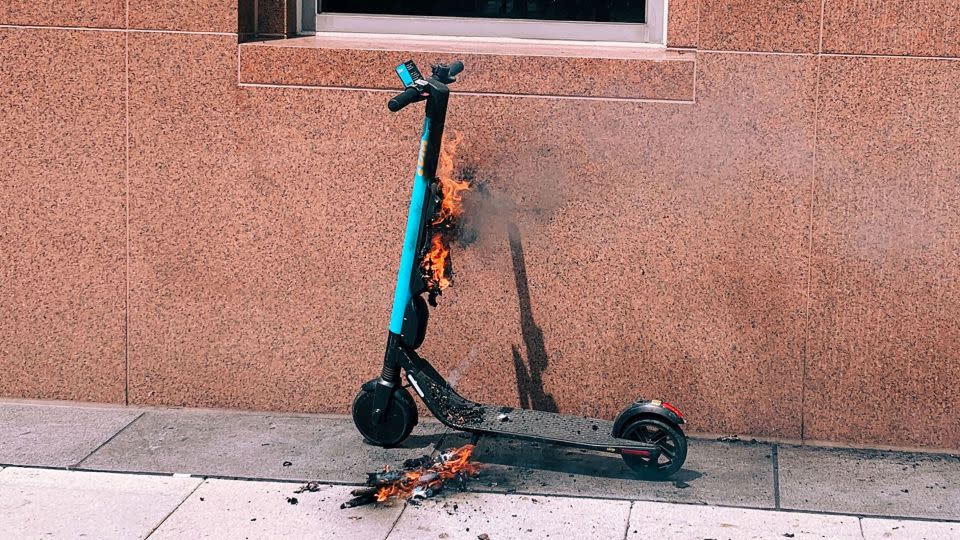Opinion: E-bike and e-scooter battery fires are killing people. Here’s how to save lives
Editor’s Note: Jim Pauley is president and CEO of the National Fire Protection Association. The views expressed in this commentary are his own. View more opinion on CNN.
Lithium-ion batteries are energy powerhouses, renowned for their long life and capacity to store high energy at a reasonable cost. They power an array of devices we’ve come to rely on, from smartphones to laptops, power tools, toys and e-bikes and e-scooters.

They allow us to be more mobile, more efficient and more environmentally friendly. Research shows that the lithium-ion battery market was valued at more than $48 billion in 2022 and is expected to continue to rise.
Yet, as the use of these batteries becomes more prevalent, especially in e-bikes and e-scooters, significant safety challenges are on full and catastrophic display. For example, the Fire Department of the City of New York (FDNY) has reported that there have been more than 100 lithium-ion battery fires this year, killing 13 people.
A recent fire in an e-bike repair store in lower Manhattan, causing four deaths and subsequently reigniting days after being extinguished, underscores the urgency of addressing this issue.
When an e-bike or e-scooter fire starts, like any other lithium-ion battery fire, it can be exceptionally difficult to control. Fed by a process known as thermal runaway, the blazes can spew toxic fumes and generally require copious amounts of water to be extinguished. Even when lithium-ion battery fires appear to be extinguished, the batteries can reignite days or even weeks later, due to energy that remains trapped inside the damaged battery cells.
Given the rapidly increasing reliance on devices like e-bikes and e-scooters by people who need them for their livelihood, including many who are often in lower income brackets and may be living and charging devices in multi-family housing, the problems become compounded. However, these problems are not insurmountable.
Solving complex fire and life safety problems demands a comprehensive approach that includes regulatory action for using and enforcing codes and standards, well-trained and resourced first responders and public education on the threat and actions that can be taken to avoid harm. Each area can play a crucial role in addressing the safety risks of lithium-ion batteries in e-bikes and e-scooters.

This ecosystem of safety is critical right now, particularly among businesses that sell, rent or repair e-bikes and scooters, as well as those that rely on them for delivery services. While it is up to federal, state and local jurisdictions to identify the needs within a given community, regulations should include limiting the number of devices allowed in various occupancies; establishing guidelines that help keep e-bikes and e-scooters away from exit doors and windows; creating protocols for safe disposal of lithium-ion batteries; and requiring that batteries bear the mark of an accredited testing laboratory.
New York City, for instance, now requires e-bikes, e-mobility devices, e-scooters and light electric vehicle battery packs to be certified to product standards by an accredited testing laboratory. As these types of provisions and guidelines are established, enforcing them will be key to ensure proper e-bike and e-scooter use, storage and maintenance.
In addition, fire departments and first responders must be trained to safely approach, extinguish and mitigate lithium-ion battery fires — not only to protect the public, but to ensure their own safety as well. The National Fire Protection Association (NFPA) actively supports national campaigns like the annual Safety Stand Down initiative, which focused on lithium-ion batteries last month as a way to increase firefighter health and safety. We encourage fire departments to participate in campaigns like this, which help strengthen their knowledge and safety in handling a wide range of lithium-battery incidents.
Lastly, people must be made aware of the potential hazards and understand how to use and maintain their devices safely to avoid potentially deadly fires. Although it can be tempting to use cheaper batteries and chargers, consumers should only purchase and use devices, batteries and charging equipment that are listed by a nationally recognized testing lab and labeled accordingly.
The FDNY has been using graphic videos and pictures on social media to show the dramatic consequences of improper charging and other hazards. Other fire safety organizations, such as NFPA and the National Volunteer Fire Council (NVFC), among others, have developed easy-to-use safety tips sheets and other resources, which can be widely distributed to better educate the public about safe e-bike and e-scooter use and storage.
These types of materials can be posted in stores as reminders for staff, shared on social media, and handed out at open houses and other safety events that fire departments host. Businesses can also make copies of these resources and pass them along to customers.
These efforts represent initial steps to address the serious unintended consequences and danger we are seeing with the proliferation of e-bikes and e-scooters. More research is needed to better understand how lithium-ion batteries ignite, explode and spread fire and toxic gases, and the findings then need to be incorporated into standards, education and fire response. Government at all levels needs to set a regulatory framework to act on information that is known, and act quickly as new information is learned to achieve better outcomes against this new threat.
Lithium-ion batteries bring advantages to society, but we must overcome the risks. By working together within the fire and life safety ecosystem framework, we can benefit from the power of lithium-ion batteries without compromising safety.
For more CNN news and newsletters create an account at CNN.com

